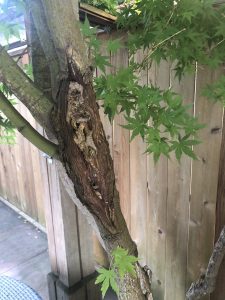
Hello,
We have a beautiful Japanese Maple tree in our backyard. She looks beautiful, however I had noticed cracks on the trunk and some of the branches, based on online reasearch, they look like they are cankers. Also, I had noticed small branches with leafs drying up…I had contacted Davey’s Tree Services, and one of their arborists had visited the tree, and said, I don’t have anything to worry about, the tree just needs pruning…
I am not sure about the accuracy of his advice…
I need second opinion, please.
This tree is the gem of our very small backyard space, and I am determined to assure her health and beauty.
Please, help.
Thank you.
Thank you for contacting the Toronto Master Gardeners.
We know how discouraging it is to see one of our prized trees sucumbing to some ailment. The first thing is to determine if your tree is indeed suffering from cankers or the result of a physical damage.
Often, the first noticeable sign of a canker is the yellowing or browning and wilting of foliage on infected branches. The canker may or may not be clearly visible. A ridge of callus tissue often surrounds visible cankers, and infected bark suffers discoloration and may produce resin. Small fruiting bodies may appear on or near the infected tissue. The article Stem Canker on a Japanese Maple gives detailed information on the canker pathogens, symptoms, cultural practices, and treatment of this disease.
Another possibility is that your tree suffered from what is called southwest damage. The following is from one of our aarchived posts:
“This past winter, in southern Ontario, was particularly harsh, not so much due to heavy snowfall, but more so due to several thaws, follow by an immediate return to the deep freeze. This can often cause tree trunks to split.
Trees respond to wounding or injury by forming specialized “callus” tissue around the edges of the wound. Thus, the tree responds to the injury by “compartmentalizing” or isolating the older, injured tissue with the gradual growth of new, healthy tissue. Not only do trees try to close the damaged tissue from the outside, they also make the existing wood surrounding the wound unsuitable for spread of decay organisms. Often a raised area of “callus tissue” will develop in the tree’s attempt to close the wound. However, even a slight opening may be enough to allow insect pests and fungal diseases to infest or infect the tree.
According to Landscape Ontario landscapeontario.com/japanese-maples“Once established, Japanese maples may be lightly fertilized only in the early spring (April) with 4-12-8 fertilizer or 15-30-15 water soluable mixture. Major structural trimming may be done before the new leaves unfurl in spring. Lighter pruning can be acomlished any time in June after the first major flush of growth begins”.
The best defense here is to use good cultural practices to ensure your tree is the healthiest it can be: make sure you water your tree during drought conditions, avoid compacting the soil around it, remove leaf debris in the fall, and amend your soil with organic fertilizers (compost) and mulch (not touching the base of the trunk but in a circle around it).”
You may wish to consult a cetified arborist for a second opinion. The Ontario chapter of the International Society of Arboriculture’s website can help you to locate a qualified arborist in your area: https://www.isaontario.com/
You might be interested in our Gardening Guide on Growing Japanese Maples as well as the following article on Disease Control for Japanese Maple Trees
Finally, we receive numerous questions concerning Japanese Maples. You can search for these archived posts simple by typing “Japanese Maples” in the search bar, located on the right side of the page.
We wish you luck with your Japanese Maple

